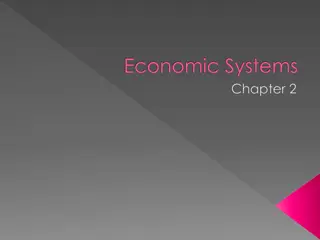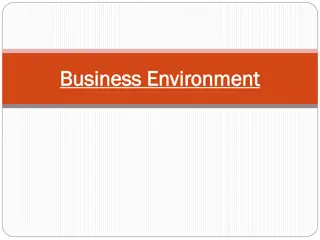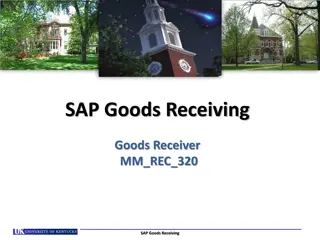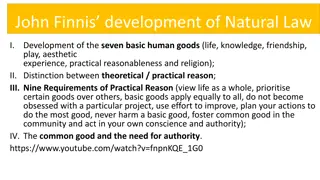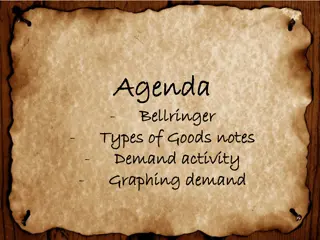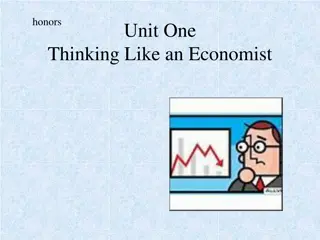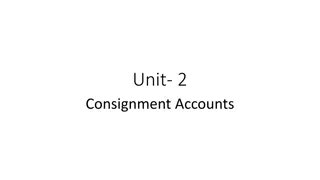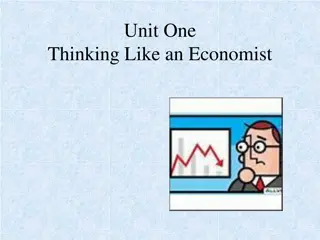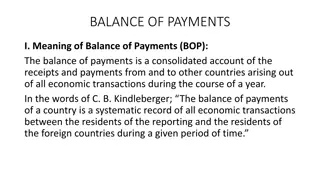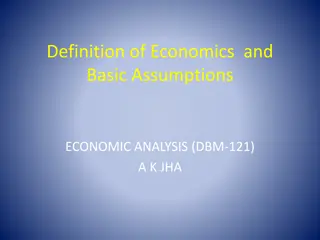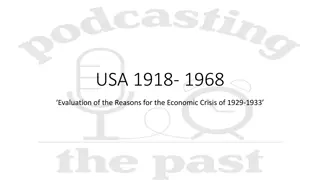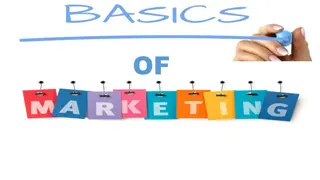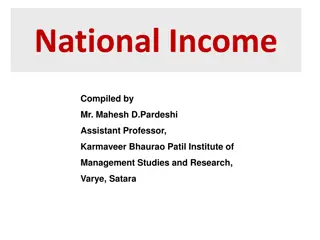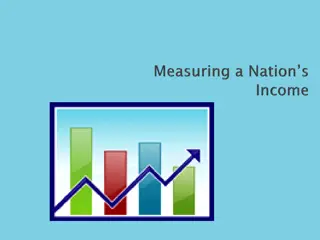Understanding Basic Economic Concepts: Needs, Wants, Goods, and Services
Exploring fundamental economic concepts such as needs versus wants, goods, services, and products. Learn about the differences between goods and services, types of goods related to income, types of goods related to price, and types of goods related to consumption ability.
Download Presentation

Please find below an Image/Link to download the presentation.
The content on the website is provided AS IS for your information and personal use only. It may not be sold, licensed, or shared on other websites without obtaining consent from the author. Download presentation by click this link. If you encounter any issues during the download, it is possible that the publisher has removed the file from their server.
E N D
Presentation Transcript
Basic Economic Concepts ECONOMIC ANALYSIS (DBM-121) A K JHA
Need and Want Need is the state of felt deprivation of some basic satisfaction. - It is a basic requirement for survival. Want is a means of expressing a need. - Human desires culminate intowants - It is a specific need forsomething Desire- Satisfying a want in a particular way
Goods, Services and Products 1.Goods All tangible things which possess utility and which can satisfy human needs and wants. 2. Services All activities and processes , which are intangible and performed to satisfy human needs and wants. 3. Products An goods or services available in the market for sale.
Difference between Goods and Services Goods Services Goods are tangible Services are intangible They can be seen and touched They can not be seen and touched. But they can be felt. Goods can be stored Services can not be stored There is a time gap between the production and consumption There is no time gap. Production and distribution are separated from consumption Services are produced, distributed and consumed simultaneously Goods are things or material Services are activities or processes Transfer of ownership is possible Ownership can not be transferred Example, Table, books, pen, etc. Example, Teaching, health services, hospitality, etc.
Types of Goods Types of goods related to income Inferior good: Goods for which demand decreases as consumer s income rises. Has negative income elasticity . Normal good: Goods for which demand increases with rise in consumer s income. Has positive income elasticity . Superior good: That tends make up a larger proportion of consumption with rise in income. Has elasticity , which is both positive and greater than 1. It might be a luxury good that is not purchased at all below a certain level of income, e,g. a penthouse ,a luxury car. Luxury good: Superior good.
Types of Goods Types of Goods - Related to Price: Ordinary good: goods for which quantity demanded increases as the price falls and, quantity demanded decreases as the price increases under ceteris paribus Giffen good: A special type of inferior goods for which demand increases with increase in prices. Example, inferior staple foods Veblen good (or ostentatious goods): Veblen goods are goods for which increased prices will increase quantity demanded. Purchased as a symbol of status
Types of Goods Typesof Goods - Related to Consumption Ability: Rival good (orrivalrousgood): Goods whose consumption by one consumer prevents simultaneous consumption by otherconsumers. Forexample, cars, and clothing. Nonrival good: May be consumed by one consumer without preventing simultaneous consumption by others, e.g. television and radio shows.
Types of Goods Types of Goods - Related to Consumption Ability: Excludable good: whose consumption can be prevented. E.g. rental accommodations Non-excludable good: it is not possible to prevent an individual from enjoying the benefits of it. Examples: Water flowing in a river,, fresh air. Public good: goods that are non-excludable as well as non-rival. It is not possible to exclude individuals from the consumption of such goods. Private good: goods that are both excludable and rival. Example: Car owned by an individual.
Types of Goods Economic goods and free goods: Free goods Those goods that exist in plenty One can have as much of them as one can without any payment. e.g., air, sunshine, etc. Economic goods Those goods which are scarce and which can be obtained only after making payment for them. Most of the things a man needs to satisfy his wants fall in this group.
Types of Goods Consumption goods and capital goods Goods can also be classified as consumption goods and capital goods . Consumption goods are those goods which yield satisfaction directly. They are used by the consumers to satisfy their wants directly, e.g., food, clothing, pen, ink, etc.. They are also called goods of the first order. Capita goods are those goods which help us to produce other goods, For example, tools, machines, etc. They are also called Producers goods or Goods of Second Order. They satisfy wants only indirectly, because they help in producing goods which in turn satisfy our wants directly. Intermediate goods are goods which are in between the consumption goods and capital goods. They are the raw materials used in the production of the final consumption goods. For example, milk as a raw material is used to prepare Paneer, butter, etc.
Types of Goods Material goods. The example of material goods are land, buildings, cash, etc. Non-material goods : Various kinds services . They are not tangible but and can be transferred. For example, The goodwill of a business. Transferable and non-transferable goods Most material can be transferred to other and thus their ownership can be changed. e.g. land, building, etc. Non-transferable goods which are non-tangible and can not be transferred to other like skill, intelligence, etc. Personal and Impersonal goods. Personal goods refer to the personal qualities of a person, e.g., his ability and skill. They are non-material and exist inside him. They are also called internal goods. Impersonal goods Those goods that are not personal. They are external and lie outside a person., e.g. land , building, etc. These are also called external goods.



